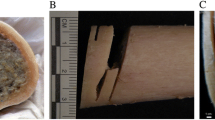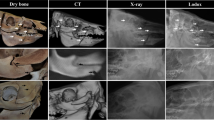Abstract
Identifying tool mark and involved weapon in sharp force trauma is essential to understanding the circumstances of death. But accuracy and reliability of such expert testimony remains unknown, and validation studies are rare in forensic literature. That is why, we conducted an experiment in order to determine error rates and predictive values on identifying the right implement through different types of knife-inflicted trauma. Human bone cut marks were analysed through epifluorescence microscopy. The samples were examined through a randomised, blinded, controlled study by three researchers with varying degrees of experience with direct and indirect observation of cut marks (photography). Our results showed that identifying the weapon involved is possible thanks to numerous criteria analysis. Correct classification rates were high and misclassifications rare. Asymmetric blades obtained better results than symmetric blades. Predictive values were also calculated, and the negative one reached very high levels, near 100% with regard to all the implements. Positive predictive values were more variable. But even if individual diagnoses remain in doubt, triage can be done and tools not implicated in injury can be eliminated with certainty. Moreover, our work clearly highlighted the importance of experience in such activities. A high level of experience is fundamental to obtain the best values, especially in such a context where evidence reliability is extremely important for forensic admissibility testimony in the court.


Similar content being viewed by others
References
Bartelink EJ, Wiersema JM, Demaree RS (2001) Quantitative analysis of sharp-force trauma: an application of scanning electron microscopy in forensic anthropology. J Forensic Sci 46:1288–1293
Lewis JE (2008) Identifying sword marks on bone: criteria for distinguishing between cut marks made by different classes of bladed weapons. J Archaeol Sci 35:2001–2008
Alunni-Perret V, Muller-Bolla M, Laugier JP, Lupi-Péruguier L, Bertrand MF, Staccini P et al (2005) Scanning electron microscopy analysis of experimental bone hacking trauma. J Forensic Sci 50:796–801
Lynn KS, Fairgrieve SI (2009) Microscopic indicators of axe and hatchet trauma in fleshed and defleshed mammalian long bones. J Forensic Sci 54:793–7797
Saville PA, Hainsworth SV, Rutty GN (2007) Cutting crime: the analysis of the uniqueness of saw marks on bone. Int J Legal Med 121:349–357
Tucker BK, Hutchinson DL, Gilliland MFG, Charles TM, Daniel HJ, Wolfe LD (2001) Microscopic characteristics of hacking trauma. J Forensic Sci 46:234–240
Symes SA, Berryman HE, Smith OC (1998) Saw marks in bone: introduction and examination of residual kerf contour. In: Reichs KJ (ed) Forensic osteology: advances in the identification of human remains, 2nd edn. Charles C. Thomas, Springfield, IL, pp 389–409
Symes SA, Chapman EN, Rainwater CW, Cabo LL, Myster SMT (2010) Knife and saw toolmark analysis in bone : a manual designed for the examination of criminal mutilation and dismemberment. Forensic anthropology at Mercyhurst College, Pennsylvania
Love JC, Derrick SM, Wiersema JM, Peters C (2012) Validation of tool mark analysis of cut costal cartilage. J Forensic Sci 57:306–311
Crowder C, Rainwater CW, Fridie JS (2013) Microscopic analysis of sharp force trauma in bone and cartilage: a validation study. J Forensic Sci 58:1119–1126
Puentes K, Cardoso HFV (2013) Reliability of cut mark analysis in human costal cartilage: the effects of blade penetration angle and intra- and inter-individual differences. Forensic Sci Int 231:244–248
Rieppo J, Halmesmaki EP, Siitonen U, Laasanen MS, Toyras J, Kiviranta I, Hyttinen MM, Jurvelin JS, Helminen HJ (2003) Histological differences of human, bovine and porcine cartilage, in: 49th annual meeting of the Orthopaedic Research Society, New Orleans, LA
Capuani C, Rouquette J, Payré B, Moscovici J, Delisle MB, Telmon N, Guilbeau-Frugier C (2013) Deciphering the elusive nature of sharp bone trauma using epifluorescence macroscopy: a comparison study multiplexing classical imaging approaches. Int J Legal Med 127:169–176
Capuani C, Guilbeau-Frugier C, Delisle MB, Rougé D, Telmon N (2014) Epifluorescence analysis of hacksaw marks on bone: highlighting unique individual characteristics. Forensic Sci Med 241:95–202
Capuani C, Telmon N, Moscovici J, Molinier F, Aymeric A, Delisle MB, Rougé D, Guilbeau-Frugier C (2014) Modeling and determination of directionality of the kerf in epifluorescence sharp bone trauma analysis. Int J Legal Med 128:1059–1066
Knight B (1975) The dynamics of stab wounds. Forensic Sci 6:249–255
Hunt AC, Cowling RJ (1991) Murder by stabbing. Forensic Sci Int 52:107–112
Cerutti E, Magli F, Porta D, Gibelli D, Cattaneo C (2014) Metrical assessment of cutmarks on bone: is size important? Legal Med 16:208–2013
Bailey JA, Wang Y, van de Goot FRW, Gerretsen RR (2011) Statistical analysis of kerf mark measurements in bone. Forensic Sci Med Pathol 7:53–62
Chumbley LS, Morris MD, Kreiser MJ, Fisher C, Craft J, Genalo LJ et al (2010) Validation of tool mark comparison obtained using a quantitative, comparative, statistical algorithm. J Forensic Sci 55:953–961
Author information
Authors and Affiliations
Corresponding author
Ethics declarations
Conflict of interest
The authors declare that they have no conflict of interest.
Rights and permissions
About this article
Cite this article
Sandras, A., Guilbeau-Frugier, C., Savall, F. et al. Sharp bone trauma diagnosis: a validation study using epifluorescence microscopy. Int J Legal Med 133, 521–528 (2019). https://doi.org/10.1007/s00414-018-1944-z
Received:
Accepted:
Published:
Issue Date:
DOI: https://doi.org/10.1007/s00414-018-1944-z




